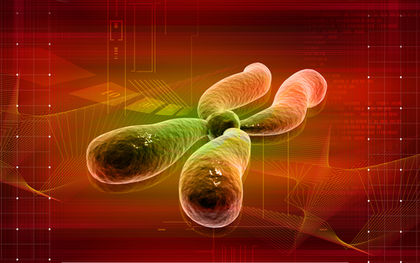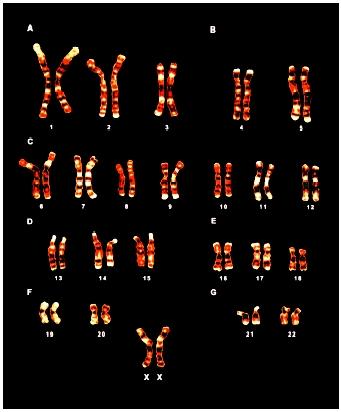Sex Determination

Sex determination refers to the hormonal, environmental, and especially genetic mechanisms that make an organism male or female.
Chromosomal Sex Determination
It is widely known that people who inherit sex chromosome X from the mother and Y from the father are genetically male, while people who inherit X from both parents are genetically female. Thus, the sex of an offspring is determined entirely by which of the male's sperm (one carrying X or Y) fertilizes the egg (which always carries X). This fact was not realized until the twentieth century, however. Before that, women were often held accountable for not producing a male heir, and in some cases even murdered for it (as in the case of Anne Boleyn, second wife of King Henry VIII).
In actuality, it is merely the presence of a Y chromosome that makes a person male and its absence that makes a person female. Through accidents of chromosomal sorting (meiosis) during sperm and egg production, some people inherit an XXY combination, but are still male (with Klinefelter syndrome). Others inherit only one X, and are thus denoted XO; they are genetically female (with Turner syndrome). Such people are often, but not

The biological law that XX results in a female and XY results in a male is true not only in humans, but in all mammals. In birds and most reptiles, however, it is the opposite: XX individuals are male and XY individuals are female. In fruit flies ( Drosophila ), XX is female and XY is male, but the Y is inert and the sex is determined by whether there are two X chromosomes or only one. (Thus, XO is female in humans but male in Drosophila. )
Not all animals have sex chromosomes. In ants, wasps, and bees (insect order Hymenoptera), sex is determined by whether or not the egg is fertilized. If it is not, it remains haploid (n) and produces a male; if fertilized, in becomes diploid (2n) and produces a female. This is true in some other invertebrates as well, such as rotifers. In whip-tailed lizards of northern Mexico and the southwestern United States, males are nonexistent. Every egg remains unfertilized and produces a female, yet females have to simulate copulation with each other to induce the eggs to develop.
Hormonal Sex Determination
Genes are not enough to make a male or female. To produce a human male requires not only the XY chromosome pair but also an adequate level of testosterone exposure during fetal development. If testosterone or the cellular receptors for it are lacking, as in androgen-insensitivity syndrome (AIS), an XY human may be born with female genitalia and misidentified as a baby girl. Conversely, if an XX fetus is exposed to a testosterone excess (from the adrenal glands), the labia may fuse into a scrotumlike sac, the clitoris may grow to resemble a penis, and the baby may be misidentified as a boy; this is called adrenogenital syndrome (AGS). The mistaken identity often comes to light only at puberty, when the individual fails to develop as he or she normally would for the mistakenly assumed sex. Such belated discovery of the child's genetic sex creates some difficult issues of gender identity.
Environmental Sex Determination
In some fish and reptiles, sex is determined by the temperature at which the eggs are incubated. In lizards and alligators, warm incubation temperatures cause all eggs to produce males, while temperatures only 1 or 2 degrees Celsius (34 or 35 degrees Fahrenheit) cooler produce females. The opposite is true of most turtles. Thus, a sea turtle might have all daughters if she lays her eggs on a beach site with full sun, but all sons if she lays them in the shade of vegetation in the dunes. Conservationists who rescue sea turtle eggs from predators and hatch them in the laboratory quickly learned that they had to vary the incubation temperature if they were to produce a mixture of sexes.
The sex of an animal is not always fixed for life. Many fish change sex at some point. In some coral reef fish, a male controls a harem of females, and the females have a dominance hierarchy among themselves. If the male dies or disappears, the top-ranking female changes into a male within a few days. Her ovaries regress, testes develop, and she/he soon produces sperm and takes over control of the harem.
SEE ALSO Crocodilians ; Female Reproductive System ; Male Reproductive System ; Reptile ; Sex Chromosomes ; Sexual Reproduction ; Turtle
Kenneth S. Saladin
Bibliography
Crews, David, ed. Psychobiology of Reproductive Behavior. Englewood Cliffs, NJ: Prentice Hall, 1987.
Daly, Martin, and Margo Wilson. Sex, Evolution, and Behavior, 2nd ed. Belmont, CA: Wadsworth, 1983.
Forsyth, Adrian. A Natural History of Sex. Shelburne, VT: Chapters Publishing, Ltd., 1993.
STEVENS, NETTIE MARIA (1861–1912)
American biologist who first showed, in 1906, that sex is determined by the presence or absence of X and Y chromosomes, thus confirming the new theory that chromosomes carry the genes and are the instruments of heredity.